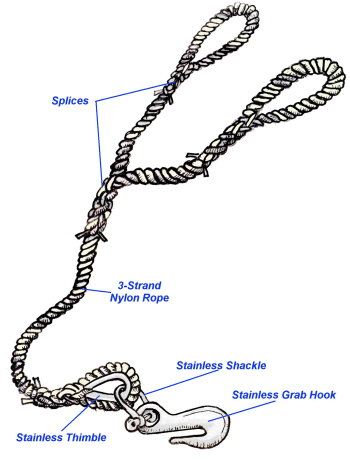The Truth about Snubbers
by Mike McEvoy/Sail-World Cruising on 27 Oct 2006

The Simple Snubber SW
No, I don’t mean someone who won’t return your ‘Good Morning’ greeting – I mean the device for protecting the anchor winch from strain in a bucking sea. Here Mike McEvoy from Middle Harbour Yacht Club gives a rundown on the value and method of using this vital yet simple piece of gear:
On a boat that has an anchor winch there are often two parts to the winch assembly. One part is to deal with anchor chain and the other, called the gypsy, deals with a rope rode or anchor line.
Some boats have rope attached to the boat end of the anchor chain so that once all the anchor chain is deployed the rope then holds the boat to the anchor. Many times, when anchoring in shallower water of course, only part of the anchor chain will be required for the anchor to hold the boat.
If the anchor chain is left on the winch drum the winch is taking all the strain of the pull from the anchor with potentially expensive damage to the gearing of the winch.
The solution is the Snubber, being a length of braided nylon rope with a loop in one end, usually spliced back on itself creating an 'eye' to hook on to a deck cleat. The other end has a purpose designed 'hook' (known as a Chain Grab Hook) that fits over the chain. The hook must be the right size for the chain - to purchase take a piece of the anchor chain or measure length and width of a link to get a hook that fits your anchor chain. Ideally the (galvanized or stainless) hook is secured to the end of the snubber rope through a metal thimble to reduce chafe on the rope.
A clevis Grab Hook pin makes it easy to attach the hook through the thimble.
Once the anchor chain has been deployed to the skipper’s satisfaction the hook of the snubber is hooked to the anchor chain just forward of the bow roller with the other looped end over the deck cleat on the deck near the bow. Your boat may have a 'Samson post' i.e. a strong point to which that you normally secure the boat’s mooring.
However, most modern production boats have a cleat on the side deck either side of the bow near the toe rail and that is where the snubber is set.
Having hooked up the snubber, keep some tension on the snubber line while you let out sufficient anchor chain to allow the snubber rope to take the full strain of the anchor. Now the strain is off the anchor winch and onto the snubber rope, which, because it has some give in it, eases the 'snubbing' action as the boat pulls back and forward on the anchor line.
The catenary, which is the dip in the anchor chain below the snubber rope, might only be a few centimeters, but could be much more – say half a metre if the swell conditions warrant it.
The snubber rope should be no more than two metres long and strong enough to
take the weight of the boat in a strong breeze. If the snubber rope breaks, anchor winch remains on the winch drum ready to take the strain if the snubber fails.
A cautious sailor, particularly in a strongly bucking sea and/or a high wind, will add two safety measures. He/she will use a much longer snubber to offer additional stretch (say six metres instead of two), and also put out a second snubber in case the primary snubber fails, to prevent the load coming onto the anchor winch.
Many long-range cruising boats put down a snubber as a matter of habit whenever riding at anchor.
If you can’t splice go to your favorite boatshed and ask them to do the two splices, one for the thimble and the other for the loop, which obviously must be big enough to fit over the strong point on the bow of your boat.
Sail-World Cruising would like to thank the www.mhyc.com.au!Middle_Harbour_Yacht_Club! for allowing the use of information from Mike McEvoy’s article from their regular magazine Compass Rose.
The diagrams used in this story are courtesy of Bosun Supplies , who manufacture professionally made snubbers and would welcome your custom.
If you want to link to this article then please use this URL: www.sail-world.com/28426